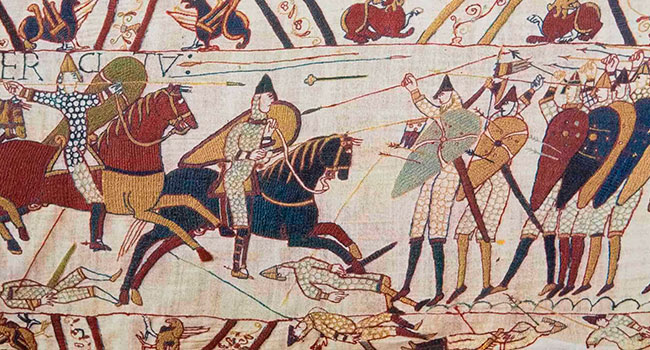 English history was fundamentally changed within a period of three weeks in the autumn of 1066. Two battles – Stamford Bridge on September 25 and Hastings on October 14 – swept away the English ruling class while simultaneously shifting the country’s external orientation from Scandinavia to France.
English history was fundamentally changed within a period of three weeks in the autumn of 1066. Two battles – Stamford Bridge on September 25 and Hastings on October 14 – swept away the English ruling class while simultaneously shifting the country’s external orientation from Scandinavia to France.
In retrospect, it was a development waiting to happen.
One of the problems was the native English system of royal succession, which has been described as a “dangerous mixture of inheritance, bequest and election.” From the legitimacy perspective, this approach had the theoretical advantage of combining pedigree and consensus. But in practice it cultivated rival claimants, disputed successions and brutal power struggles.
There was also the matter of the Vikings with whom England had been struggling since the looting of Lindisfarne in 793. Ever the opportunists, the Vikings were quick to take advantage of disunity, even going so far as to rule the country from 1016 to 1042. Historian Robert Tombs put it wryly: “The Danes decided that if the English were so rich, they were worth conquering completely.”
Things began to decisively fall apart when, after reigning for almost 14 years, Edward the Confessor died in January 1066. Leaving no children, Edward’s demise set the stage for multiple claimants, and the situation wasn’t alleviated by Harold Godwineson’s speedy assumption of the crown. Harold had succeeded to the south of England earldom of Wessex in 1053, and the Godwines were a notably ambitious – some would say rapacious – family.
One rival claimant was the Norwegian king Harald ‘Hardrada’, who promptly assembled an invasion force of around 11,000 men and up to 300 ships. By early September, he was on the north-east coast.
Meanwhile, the other main competitor, Duke William of Normandy, was also busy raising an army and getting papal blessing. However tenuous it may have been, William pressed the moral legitimacy of his claim – two promises plus a distant familial link. But his on-the-ground recruiting spiel included the lure of “lands, treasure and wealthy English brides.” He was on the south coast by late September.
Faced with these challenges, Harold didn’t shirk. On September 25, the Battle of Stamford Bridge in Yorkshire was “perhaps the most complete annihilation in medieval military history.” Legend has it that only 24 of the original 300 ships were required to transport the defeated Viking survivors back to Norway.
Harold then turned south to meet William, coming to grips on Saturday, October 14, about seven miles from the current East Sussex town of Hastings. It was a fiercely punishing all-day affair ending in a decisive Norman victory. At the finish, Harold, the last Anglo-Saxon king of England, lay dead on the field. Whether he was killed by an arrow through the eye, trampled underfoot, or hunted down and (literally) cut to pieces by a group of Norman knights remains a matter of speculation.
The ultimate consequences for England were profound. In the pithy summation of historian Tombs, “The Conquest annihilated England’s ruling class, physically and genetically.” This, of course, applied only to the male line. Willing or otherwise, wealthy English widows and heiresses were married off to William’s key followers.
The Domesday Book (1085-86) provides a window into the scope of the change in land ownership. The country it described was effectively “controlled by about 250 people … practically all newcomers.” Of the major landowners, only four were English. To all intents and purposes, England’s aristocracy had become French.
And the changes associated with the Norman Conquest went beyond land ownership.
There were new building styles (Romanesque architecture and stone castles), changes to inheritance law (primogeniture), the abolition of slavery, and a sharp reduction in the use of murder and mutilation for political ends. While the Normans weren’t proto-human rights advocates, their modus operandi differed from that of the Anglo-Saxon aristocracy they displaced.
France also became a focal point for both trade and politics. England’s new owners had a strong interest in retaining possession of their hereditary French lands, which naturally translated into several centuries of military involvement across the English Channel.
Even today, the Conquest’s effects linger. Asked what advice he’d give to someone aspiring to be rich, the Duke of Westminster mentioned the value of having “an ancestor who was a very good friend of William the Conqueror.”
Troy Media columnist Pat Murphy casts a history buff’s eye at the goings-on in our world. Never cynical – well, perhaps a little bit. For interview requests, click here.
The opinions expressed by our columnists and contributors are theirs alone and do not inherently or expressly reflect the views of our publication.
© Troy Media
Troy Media is an editorial content provider to media outlets and its own hosted community news outlets across Canada.


